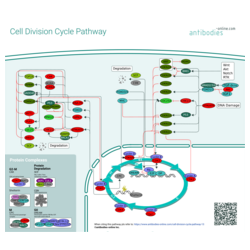Cell Division Cycle
All organisms (single and multi-cellular) rely upon reiteration of growth and division of existing cells under favorable conditions. During each round of this process, the cell cycles through an ordered series of events in which its genetic information is duplicated and then divided among two daughter cells. These events are tightly regulated and certain checkpoints must be passed in order for the cell cycle to be completed. The loss of control of these processes is a hallmark of cancer.
The cell cycle is split up into four major phases based on the events unfolding in the cell. During the first gap phase (G1) the proteins are produced that are essential for DNA replication. The genetic information is then being replicated during the synthesis (S) phase. In the second gap phase (G2) all the components that are necessary for the separation of the duplicated DNA during the subsequent mitosis (M phase). Cells that are not actively dividing are considered to be in a quiescent state in the resting phase G0.
Cell division is necessary for life, but unregulated division is dangerous and counterproductive. Therefore, the cell has an impetus for maintaining tight regulatory control over how and when division takes place. There are two major checkpoints in the cell cycle. The first choke-point the cell must pass is between the G1 and S phase. A second opportunity for arrest is provided between G2 and M phases. Once DNA replication has been initiated, it must be finished. Therefore, the major checkpoint in the cell cycle is the restriction (R) point between G1 and S phases, prior to DNA duplication, at which the cycle progresses depending on mitogenic or inhibitory factors such as DNA damage and signals from various signaling pathways.
Progression from one phase to another is controlled by cyclin dependent kinases (CDK) and their activators, cyclins. Latter proteins are unstable and their cellular concentration cycles throughout the cell cycle. Accordingly, specific cyclin-CDK complexes persist in an active form for a very short period of time after translation, and are then degraded or inactivated by the time that particular phase of the cell cycle completes. Activation of specific cyclin-CDK complexes are characteristic for the different cell cycle phases, and drive production of specific molecules associated with, and necessary for that phase of division. Additional levels of dynamic control are also provided by CDK inhibitors, which block CDK function even in the presence of their requisite cyclin.
References
- : "Unraveling Cell-Cycle Dynamics in Cancer." in: Cell systems, Vol. 2, Issue 1, pp. 8-10, (2018) (PubMed).
- : "Cell cycle development." in: Developmental cell, Vol. 6, Issue 3, pp. 321-7, (2004) (PubMed).
- : "The cell cycle, cancer development and therapy." in: Molecular biology reports, Vol. 49, Issue 11, pp. 10875-10883, (2022) (PubMed).
- : "Mammalian cell cycle cyclins." in: Seminars in cell & developmental biology, Vol. 107, pp. 28-35, (2021) (PubMed).
- : "The cell division cycle and the pathophysiology of Alzheimer's disease." in: Neuroscience, Vol. 87, Issue 4, pp. 731-9, (1998) (PubMed).





